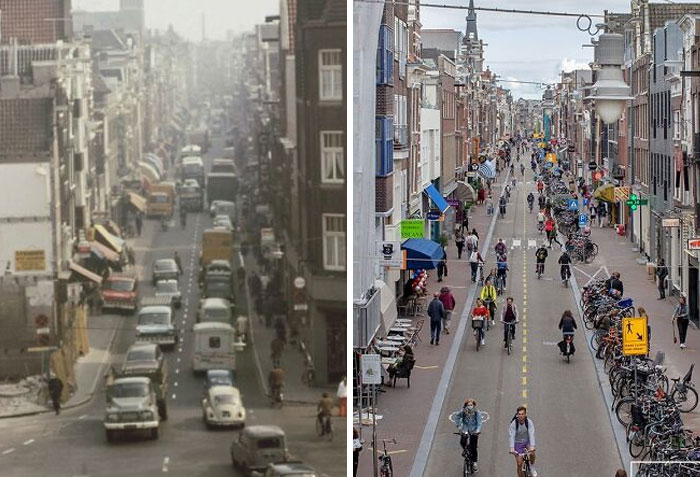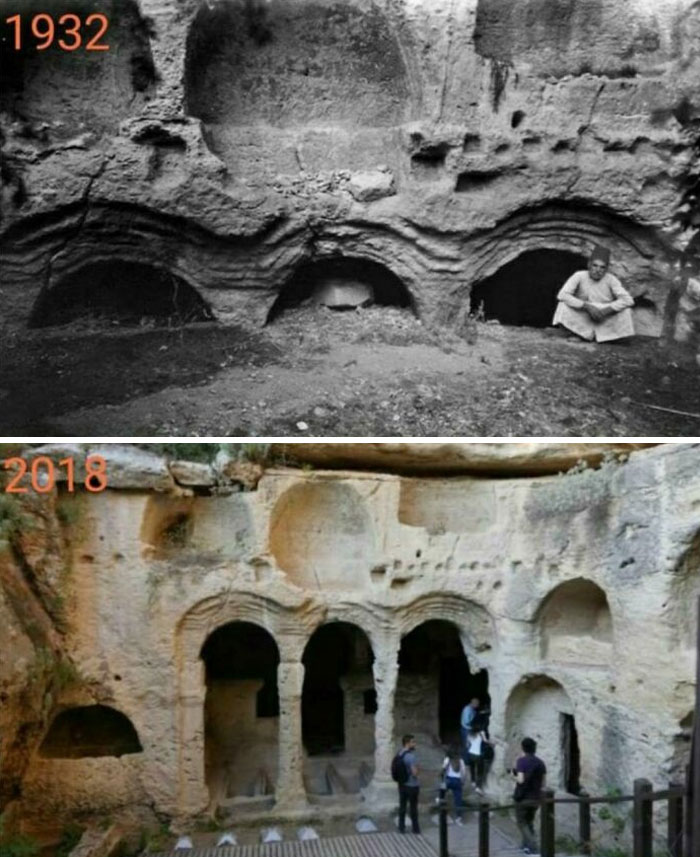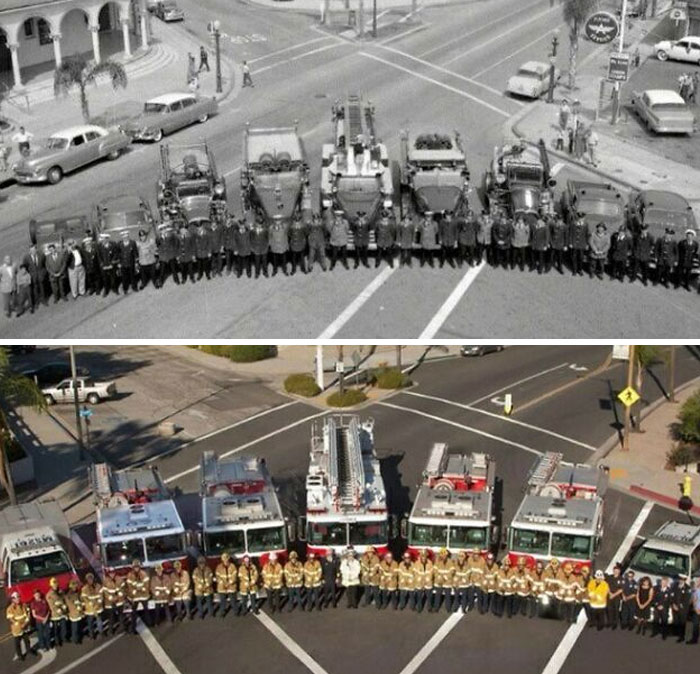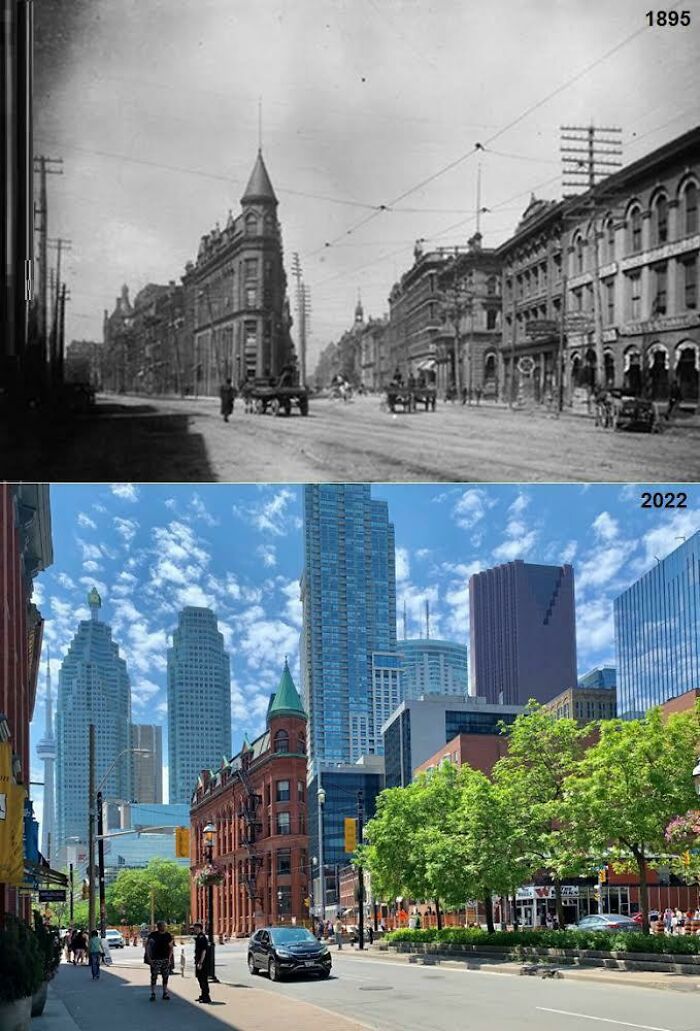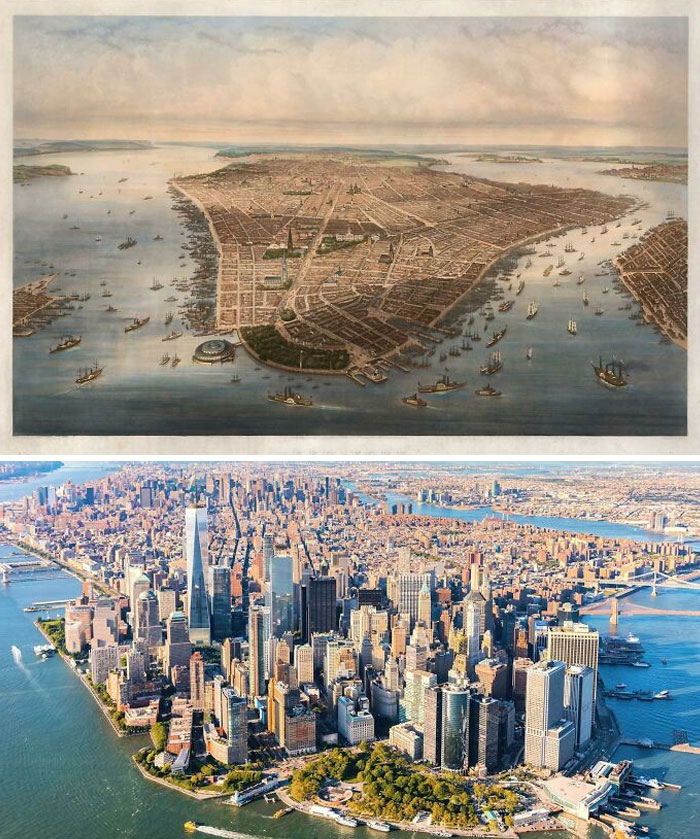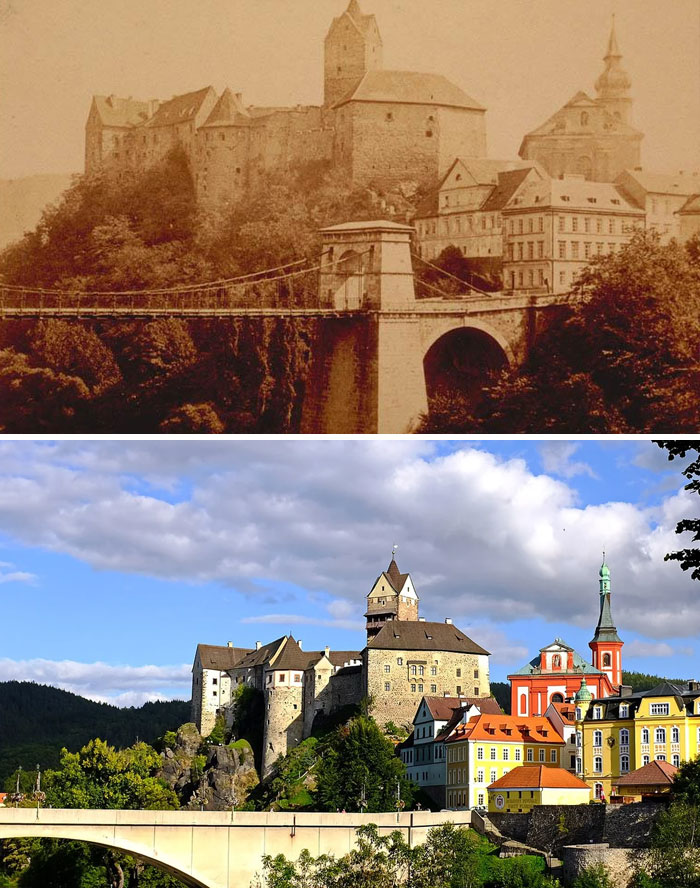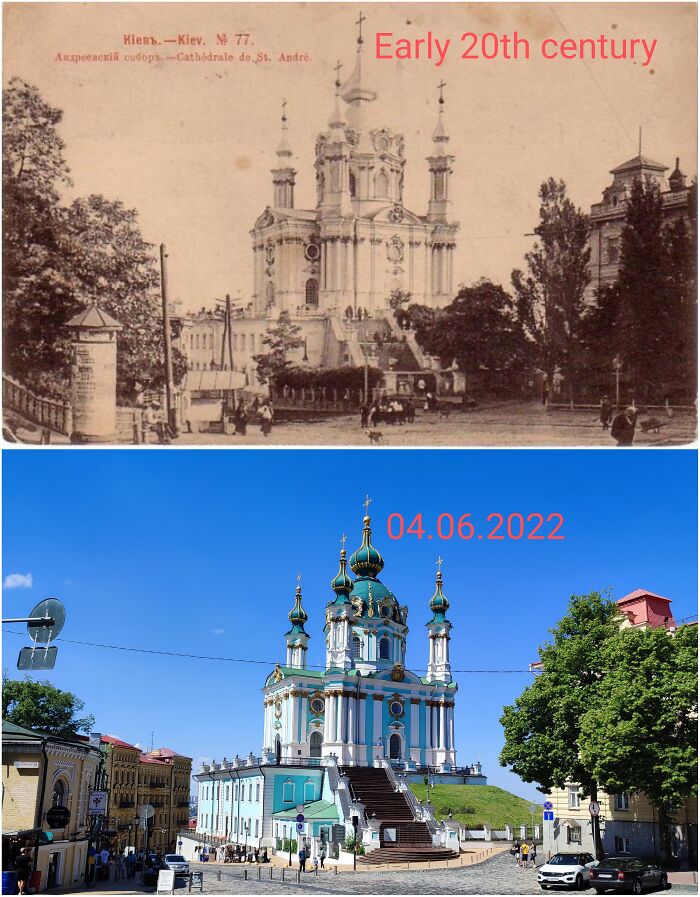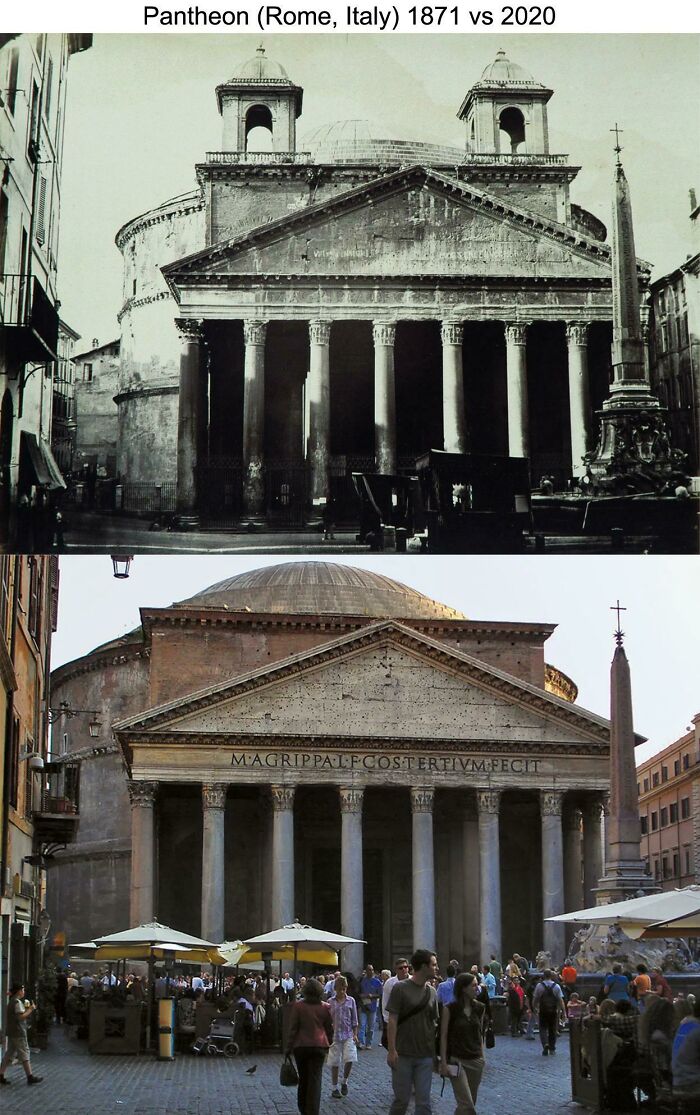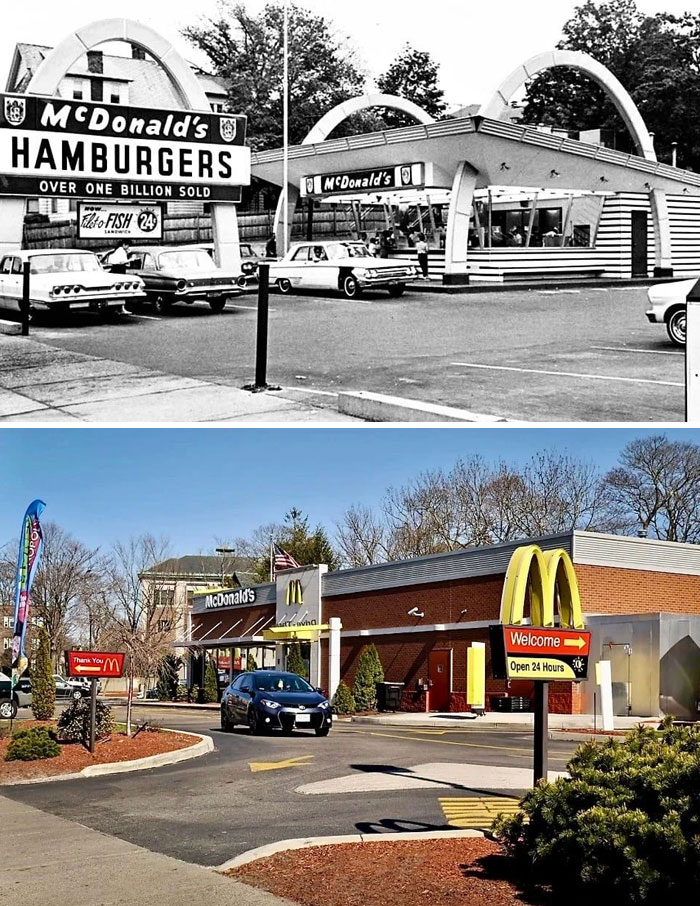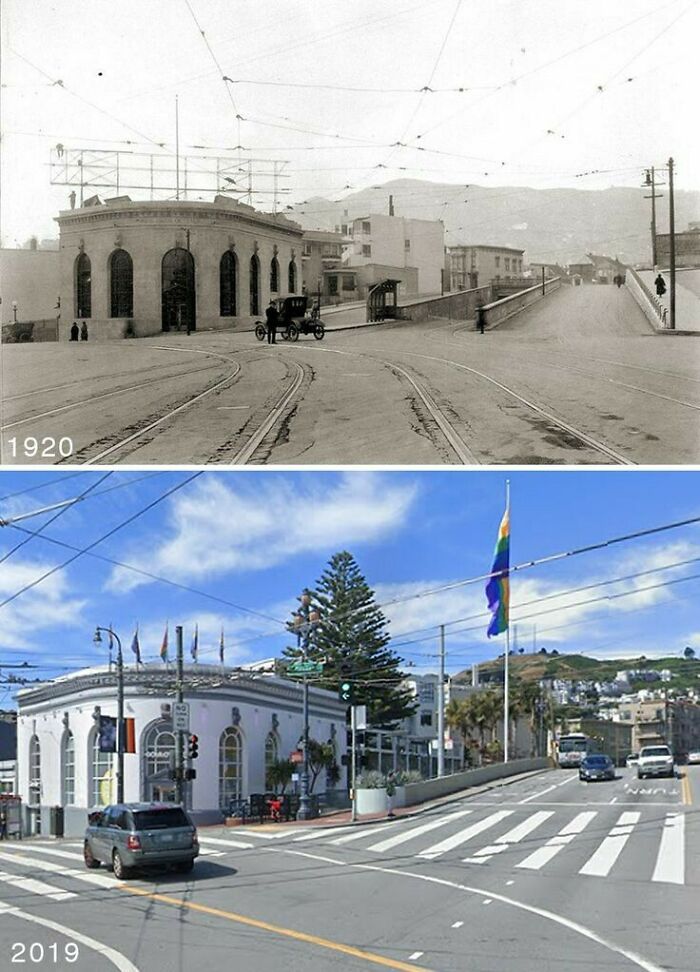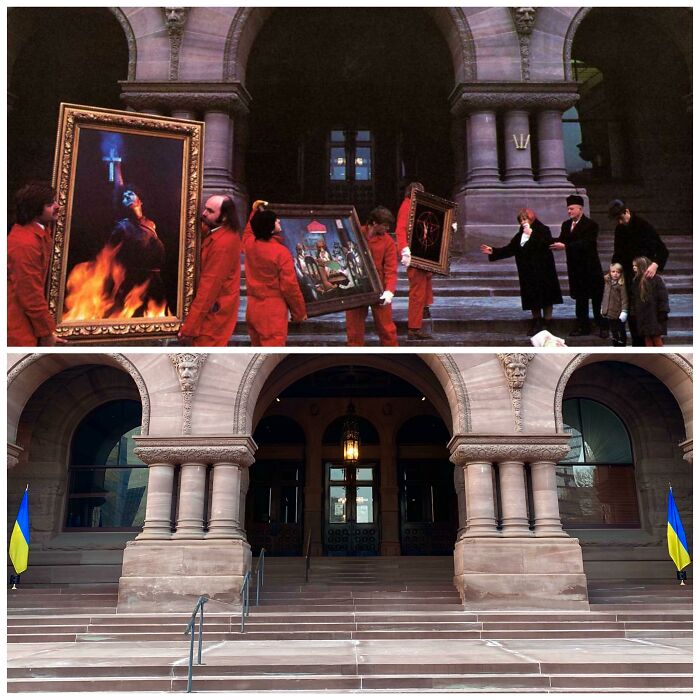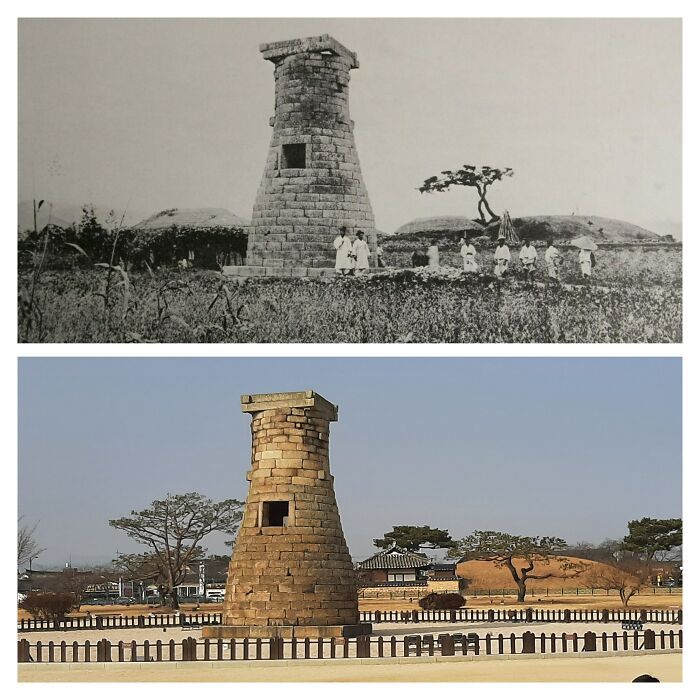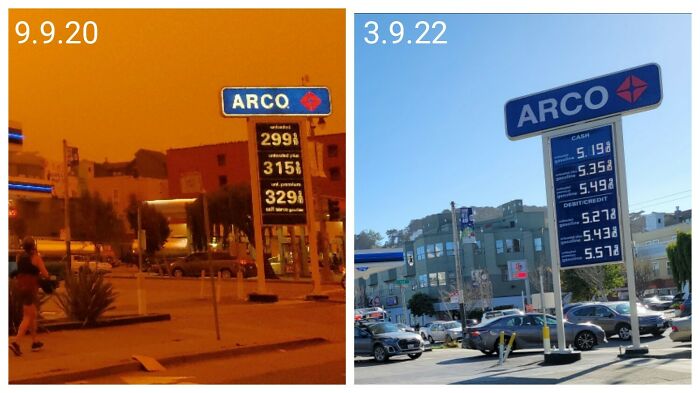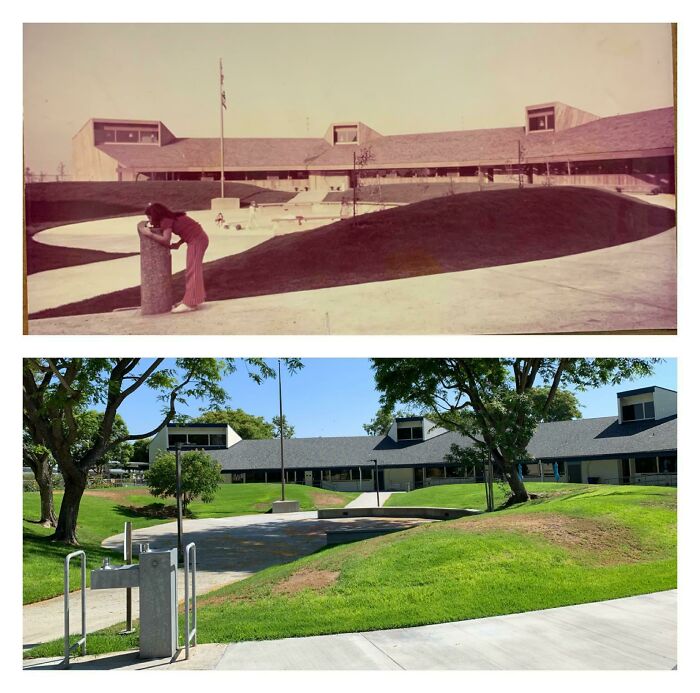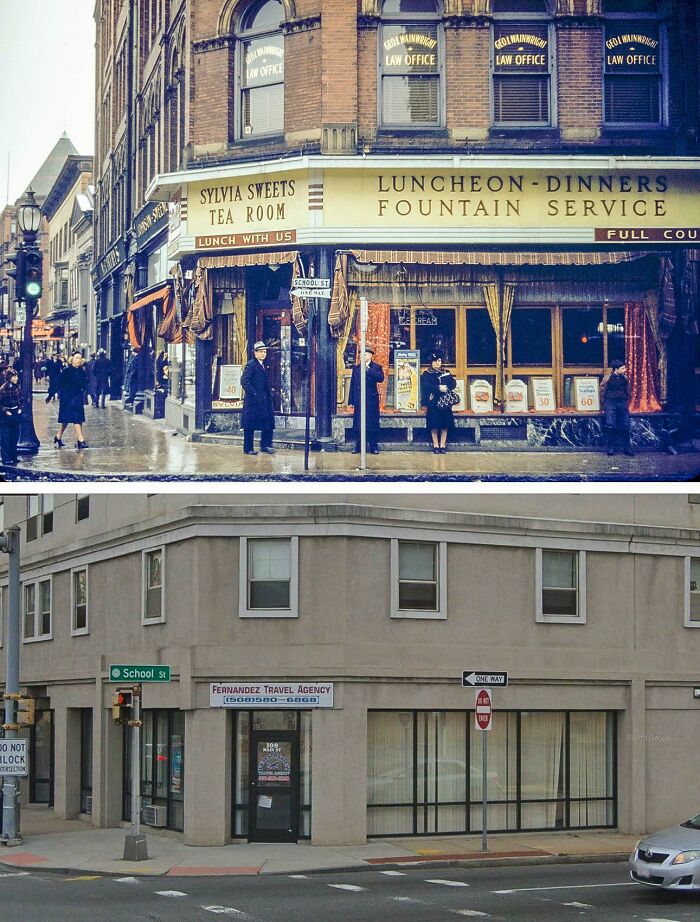
‘Old Photos In Real Life’: 30 Pics That Show How Much Time Affects Everything (New Pics)
Rephotography is the act of repeat photography at the same site, with a time gap between the two images; the so-called "then and now" view of a particular area.
Some of these images are pretty casual in terms of their artistic expression, usually taken from the same viewpoint but without trying to recreate the same "vibe" of the original shot. Others, however, are produced very precisely. Either way, they provide very interesting insights into the passage of time and its effect on the world.
Hands down, the best online archive of such pictures is the subreddit r/OldPhotosInRealLife. Natural wonders, urban settlements, you name it, it has it all. Continue scrolling to check out the most popular recent posts among its members, and be sure to check out our earlier publications on the subreddit here, here, and here when you're done, too.
This post may include affiliate links.
1980s And Nowadays, Forestation By Hikmet Kaya In Turkey
Tiergarten, Berlin (1945 & 2021)
According to The Difficult Knowledge Project, a University Of British Columbia initiative led by Dr. Amy Scott Metcalfe, rephotography developed in the natural sciences to demonstrate environmental change, such as erosion or receding glaciers, and has been applied to fields such as sociology to show social change, usually in the built environment (e.g., towns and cities).
Rephotography can also be applied to, for example, the campus or school setting as a way to discuss organizational change and other aspects of the environment.
To get a better understanding of this interesting genre, we also spoke to its contributor, photographer Nicole L. Lashar.
Haarlemmerdijk Street In Amsterdam, Netherlands (1971 And 2020)
Boston - Elevated Highway Moved Underground, Replaced With Green Space. (1990s V. 2010s)
1910 Great Flood Of Paris
"When I began exploring rephotography, I was passionate about pursuing photography as an art form and I was equally excited about traveling to new cities and exploring the art and architecture," Nicole Lashar told Bored Panda.
"Rephotography allowed me to combine the artistry of photography and travel into one experience. At first, it was not the end result that mattered, but the experience of exploring new places and stepping back in time to try and find the exact perspective of the original photographer. But as I continued, the significance grew."
This Is A Photo My Great Grandfather Took In Youngstown In 1951 And A Photo I Took Yesterday
Roman Theatre Of Cartagena (Province Of Murcia, Spain) 1991 vs. 2021
My House - Lillington, Nc - 1914 And Last Year
Is the house sinking? The ground seems much higher up on the porch in the second photo
Kharkiv, Ukraine 2015 And 2022
Lashar said her rephotographs explore differences, mostly in architecture from an early, historical photograph to its current appearance, "not by side-by-side comparisons but through transparent, overlapping images transposed onto each other thus resulting in aesthetic artwork."
"The perspective created by combining the photographs allows the viewer to see two time periods simultaneously. The viewer has a new outlook on the space as they see the present colliding with the past," the photographer explained.
Minami-Sanriku (Japan) 2011 vs. 2020
Poznań Old Square - Ww2 vs. 2021
1946 vs. 2021 - Poznań, Poland
Besikli Cave Tomb In Hatay, Turkey
If all of this process sounds difficult, well, that's probably because it often is much more than simply taking a picture.
"The biggest challenges for rephotographers as they're creating 'then and now' imagery are sourcing the original photograph, finding the exact location as the addresses are rarely known, and then getting the perspective correct when they're photographing," Lashar said.
Positano, Italy A Century Apart (1920/2022)
A German Aa Battery In Aasenfjord, Norway. A Transparent Screen With A Photo From The War Is Placed So You Can See What It Looked Like When New
1916 vs. Now- Verdun Battlefield, France
The "Dead marshes" in Tolkien's "The Lord of the Rings" were inspired by the battlefields of WW1, more specifically the body-filled craters left after the shellings. Tolkien fought in the war and created the foundations of his Middle Earth mythos precisely during those days.
Butchery Lane, Canterbury, In 1895, 1920, 1992 And 2022
"My rephotography was based on architecture, making it a bit easier to find the exact location," Lashar started explaining her own approach.
"I would select a location first based on proximity within the city, the age of the building, and the number of historical photographs of the building. Then I would search through image databases to find the best image. It can be hard to find a high-resolution photograph that is available for free and fair use. I was able to use satellite imagery, such as that found on Google Maps Street View to ensure the building was not demolished and that there were other reference points to help rephotograph the site."
1000 Year Old Toghrol Tower In The City Of Rey, Iran. First Photo Taken In 1840’s
1878 - 2022. Tetons. Not Much Has Really Changed In This Photo. But I Still Think It's Neat
Redlands Fire Department Group Photo 1958 And 2012 @ Intersection Of 35 Cajon St, Redlands, Ca
Gooderham Flatiron Building, Toronto (1895 vs. Today)
I live very nearby. It's honestly crazy to see how this city has grown and evolved over the past 15 years or so, let alone the past 125+. When the first photo was taken, Toronto was essentially a backwater with dirt roads, a railroad station, a whiskey distillery and grain storage complex, and a bunch of pork processing facilities (hence the nickname Hogtown). Today, it's a global capital of technology, culture, finance and tourism (or "Alpha" city if you prefer), and the 4th most populous city in North America after Mexico City, New York and Los Angeles, in that order. Blows my mind sometimes to have watched it grow up from the early 90s till today.
While researching the satellite images, the photographer often notices much larger structures surrounding the building in question, and the perspective of the original photograph would not have been possible with the current state of the surroundings.
"When photographing, I took several different angles and revisited the reference image multiple times to match it up as closely as possible. The original location of the photograph, height perspective, and type of lens or camera all played a role in the possibility of lining the photograph up perfectly. At times the desired results were not physically possible based upon equipment or location proximity."
Manhattan In 1851 And Today
Maybe for aliens watching from above, the building light look synonymous to some kind of fungal growth.
Avril Lavigne's First Album Shoot 2022 vs. 2002
Fascism To Kebabs, Durham 1934 V 2020
Baroli Temples, Baroli, Rajasthan, India. Built 10th Century Ce. Sketch From 1850 And Picture From 2018
A good rephotograph, according to Lashar, allows the viewer to effortlessly hop in time and see the same place in different periods.
"Mark Klett, the master of landscape rephotography, explains in his book After the Ruins that a rephotograph is most successful when the 'viewers are convinced they are seeing the same place. That is less about technical accuracy than visual verification,'" Lashar highlighted.
"However, a great rephotograph elicits emotion or pondering from the viewer by displaying social, typological, or infrastructural change. By viewing the two time periods simultaneously, each viewer, affected by their own perception and prior knowledge, has an emotional response or questions the changes that have occurred."
Ent To NYC And Had A Free Day So I Visited Some Iconic Album Cover Locations
Torun, Poland
Royal Victoria Hospital, Montreal. 100 Years Apart
Roman Forum (Rome, Italy) Before 1864 vs. Today
Loket, Czech Republice 1900 And 2019
St.andrew's Church, Kyiv, Ukraine. Then And Now
Roman Theatre Of Mérida (Extremadura, Spain) Around 1912 vs. 2018
Twa Terminal In Jfk In 1968. Now A Hotel Lobby
U.S. Patent Office In 1924 vs. 2018 (Now The The National Portrait Gallery And American Art Museum)
Salem Street Jail | Salem Ma | 1992 & 2021
Chaukhandi Stupa, Sarnath, India. Originally Built Between 4th And 6th Centuries By Gupta Dynasty To Mark The Site Where Buddha And His First Disciples Met. Octagonal Tower Was Added In 1588 By Raja Todar Mal To Commemorate The Visit Of Mughal Humayun. Photos From 1860 And 2020
Prague, Czechia
Vishram Ghat - Mathura, India
I love that India retains so much of it's culture despite having been occupied by the British. We've got enough "westernised" countries and cultures as it is and Indian culture is so beautiful and fascinating.
Trevi Fountain, Rome
Quai D’anjou, Paris. 1926 (Eugene Atget) And 2020 (Me)
1930s vs. 2021, Same Location, Ona Lighthouse, Norway. Lighthouse Constructed In 1867 And Still Active
Sarajevo 1996 vs. 2012
Hawa Mahal In Jaipur, India (1895 And 2021)
Mount Rushmore (1905-2019)
Shahabad Castle, Rampur, India. 1911 And 2021
Lombard Street San Francisco 1920s And Today
Pantheon (Rome, Italy) 1871 vs. 2019
Waterford, Ireland - 1910 vs. Today - Markets Took Place In This Little Village As Far Back As 1680
The Ancient Theatre Of Delphi, Greece
Grand, France : Roman amphitheatre.(17000 seats) built in the first century AD grand-62be...ad223b.jpg 
Bristol, Gloucestershire
I see a red door, And I want it painted black, No colors anymore, I want them to turn black. Great song, sad development.
San Francisco 1920 And 2020
Manikesvara Temple, Lakkundi, India (1880 And 2017)
It's a step well, in the first picture the water level is very, very high!!
Churfürstliche Fuchsjagd, Tiergarten, Berlin (1945 And 2020)
Süreyya Beach In 1940s And Nowadays, Istanbul
Intersection Of Beaufait And Darby Avenues, Porter Ranch, San Fernando Valley, Los Angeles - From A Scene In “E.t.” In 1982 And In 2022
The 2100 Year Old Chaitya Hall Of Ajanta Cave 10 In Maharashtra, India. As Seen In 1839 And As Seen Now
Hiran Minar Or Ivory Tower, Fatehpur Sikri, Agra, India. Built By Mughal Emperor Akbar Between 1571 - 1585. Photos From 1893 And 2019
Pollok House Gardens, Glasgow, 1908 And 2022
Fifth Avenue From 34th Street In NYC, Around 1912 And 2016
10 Years In Detroit. 2009 And 2019. House Proud Lawn Mowing To Abandoned Debris
Ray Liotta And Joe Pesci Outside A Queens, NY Diner In The Movie Goodfellas (Filmed In 1989)
Elio Callistio Square (Rome, Italy). Around 1900 vs. 2017
Ransom Gillis House Detroit
I love old houses like this. Hope they retained the original beauty on the inside.
Ypres, Belgium During Ww1. How It Looks Today
Gonzales County Courthouse Gonzales, Texas. (1939 And Today)
Smith Square, Westminster - 1920s vs. 2022
Michigan Supreme Court Judge James V Campbell's House, 261 Alfred St, Detroit, Mi (1882 And 2017)
Buddhist Pagoda, Eden Gardens, Kolkata, India. Brought To Kolkata In 1854 From Prome, Burma By Lord Dalhousie As A War Trophy After 2nd Anglo-Burmese War. Built 1852. Photos From 1885 And 2019
The Dining Cars Cafe In Buellton, California. Open From 1946 To 1958, The Diner Incorporated Two Former La Streetcars Into Its Architecture. It Had Been Closed For Almost Two Decades By The Time The Top Photo Was Taken. (1976 vs. 2012)
Monaco In To Catch A Thief In 1955 And In 2021
Church Of The Redeemer In Toronto, 98 Years Apart
Oxford Street, London - 1941 vs. 2022
Downtown Toronto (1953 vs. 2017)
Eastwick, Philadelphia, 1927 (Colorized) vs. 2022
The First McDonald's In Worcester - 1964 vs. 2021
San Jacinto Plaza, El Paso, Tx. 1900ish vs. 2022 (Not The Same Angle But Close Enough)
Market & Castro Street, San Francisco, Ca (1920 And 2019)
The View From The Empire State Building In 1931 And 2011
Rail Station In Bak, Poland 1930 And 2004
The Hotel Kaaterskill On A Mountaintop In The Catskills Of New York, Around 1900-05 And The Scene In 2021
Just in case someone else was wondering what happened: "During a soap-making process in 1924, a fire broke out, and it soon spread from the kitchen to the rest of the hotel. The building’s wood-frame construction, combined with its isolated mountaintop location, allowed the fire to spread throughout the hotel, and by the time firefighters arrived there was little that they could do. The fire burned throughout the night, where it could reportedly be seen from as far away as Massachusetts, and by the next morning there was nothing left but smoldering ruins. The fire caused an estimated $250,000 in damage, only half of which was insured. The hotel was never rebuilt, in part because by this point the era of grand mountaintop hotels had passed."
Colossal Statues Of Varaha Lifting Bhudevi (Earth), (11 Feet High) And Vishnu (Back, 13 Feet High). Carved Between 500-600 Ce. Eran, Madhya Pradesh, India. Photos From 1893 And 2018
Mulberry Street, Little Italy, Manhattan - 1900 & Now
The TV Western 'Gunsmoke' Ran For 20 Years From 1955 Until 1975 With 635 Episodes. Below Is A Picture Of The Set During Filming And Again As It Appears Today
Qingdao 1914 - 2022
Gadermal Temple, Madhya Pradesh, India
NYC: 8th Ave/32nd St (Penn Station & Msg), 1910 (Colorized) vs. 2019
Hilltop View Of El Paso Texas, 1880s vs. 2010s
I was stationed there at Ft Bliss (not blissful). But the view of the city from the mile high "mountain" was just gorgeous overlooking El Paso.
The Ontario Legislative Building In Canada - 1981 And 2022
Cheomseongdae In Gyeongju, Korea
Before 9/11 And After 2015
The Day The Sky Turned Orange In San Francisco vs. Today
1921-2020 Ogden, Utah
Irvine, Ca. 1976 vs. 2022
As a person in a wheelchair I appreciate the accessable drinking fountain.
Corner Of School And Main Streets, Brockton, Massachusetts In 1940 vs. 2018. (1940 Photo By Jack Delano Via Library Of Congress.)
Tomb Of Mughal Adham Khan And His Mother Maham Anga. Delhi, India. Built 1562. In 1830s, A British Officer Named Blake Of Bengal Civil Service, Converted This Tomb Into His Residential Apartment And Removed The Graves To Make His Dining Hall. Only The Grave Of Adham Was Restored By Curzon In 1901
Random Street Corner In Queens, NY (Date Unknown)
City Hall In Vicksburg, Mississippi (1906 vs. 2018)
Aww man they removed the trumpeting angels in the second picture. I liked it better in the before picture.
A Hallway In My High School, 1973 vs. 2022
Kurt Cobain And Courtney Love With Frances Bean In 1992 At Their Hollywood Heights Home
So sad what that house looks like now. Surprised it's not been loved and kept up...
The Road To Grandfather Mountain Today (June 2, 2022) And When Forest Gump Ran There In 1976
Tom Hanks ran there in the 1990's when the movie was made, it wasn't actually 1976.
A Group Of Child Laborers At The Indian Orchard Manufacturing Company In Springfield Mass In 1911, And The Scene In 2014
Gavi Gangadharesvara Temple In Bangalore, India. Renovated In The 16th Century Ad By Kempe Gowda, The King Who Fortified Bangalore. Artist And Engraver: Daniell, Thomas (1749-1840). Medium: Aquatint, Coloured. Date: 1808
Hong Kong Harbour. Hms Indomitable, September 1945 vs. Today
Corregidor Island Hospital In Philippines, 1942 And 2018
Grand Synagogue, Lodz (1881 - 2022)
The dates listed don't look accurate. The Great Synagogue of Łódź was set ablaze by the Nazis on the 14th of November, 1939. All of the scrolls were destroyed. The following year the remains of the synagogue were dismantled.
What’s always most striking to me, when it comes to city pictures like the ones here, is ti distinct lack to trees dotting the sidewalks, not to mention total lack of green spaces. I am so glad we realized that cities need country-like spaces too, and that more trees, green spaces, and pedestrian-only streets mean better air quality—-which not only benefits human lungs, but also cuts down on erosion of buildings (yeah, the chemicals in car exhaust and factory smoke are toxic to brick and stone, as well as flesh and blood).
My father has a series of journals from 16th century missionaries in Brazil. He and I did a tour where we tried to find the spots with hand drawings, and the locations in the modern city of Rio de Janeiro. It took us a few days in some cases, but it was worth it. They are mostly unrecognizable. Rio in the early 1500s was still very much forest. Mostly we had to match up the coast-lines, or look far larger landmarks like mountains. But waterways have been moved, even coastlines have been altered with land reclamation projects.
And now it's a shitty city with lots of violence, corruption, and infrastructure problems.
Load More Replies...What’s always most striking to me, when it comes to city pictures like the ones here, is ti distinct lack to trees dotting the sidewalks, not to mention total lack of green spaces. I am so glad we realized that cities need country-like spaces too, and that more trees, green spaces, and pedestrian-only streets mean better air quality—-which not only benefits human lungs, but also cuts down on erosion of buildings (yeah, the chemicals in car exhaust and factory smoke are toxic to brick and stone, as well as flesh and blood).
My father has a series of journals from 16th century missionaries in Brazil. He and I did a tour where we tried to find the spots with hand drawings, and the locations in the modern city of Rio de Janeiro. It took us a few days in some cases, but it was worth it. They are mostly unrecognizable. Rio in the early 1500s was still very much forest. Mostly we had to match up the coast-lines, or look far larger landmarks like mountains. But waterways have been moved, even coastlines have been altered with land reclamation projects.
And now it's a shitty city with lots of violence, corruption, and infrastructure problems.
Load More Replies...
 Dark Mode
Dark Mode 

 No fees, cancel anytime
No fees, cancel anytime 









